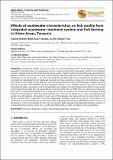| dc.description.abstract | Availability of suitable water is one of the most important limiting factors for development of sustainable
aquaculture in the urban areas. As a consequence, the use of wastewater effluents for aquaculture is on the rise in developing
countries, Tanzania being one of the implementing country; quality of fish from such environments becomes questionable for
human consumption. Clarius gariepinus were raised in selected Wastewater Stabilization Ponds (WSPs) at Moshi Municipal
(Maturation two (M 2), four (M 4), six (M 6), fish pond (FP) and Lake Duluti (LD as Control site) for ninety days to
investigate fish contamination (heavy metals and microbial) and body composition. Among all seven selected heavy metals
(Hg, Cd, Mo, Cr, As, Zn and Pb) only four (Hg, Cd, Cr and Zn) were detected in analyzed fish and water samples, while (Pb,
Mo and As) was below detection limits of X-Ray Fluorescence (Spectro xepos –EDXRF) analyzer. The results revealed that
fish sample had higher concentration of detected metals than water samples from all treatments except for Hg of water sample
from M2 and M4 was higher than fish sample and above the permissible limits by WHO. There was variation in crude protein
and crude fat in analyzed fish samples from all treatments site. The fish reared in M4 contain higher percentage of crude
protein (81.36) and crude fat (18.45) than other treatments. Escherichia coli and Staphylococcus aureus were detected in fish
samples from all treatments with number of counts was within standards, while Salmonella spp was only present in M2.
Results from this study reveals that with proper management, maturation ponds can be used for fish production but
maturation two should be abandoned for fish farming due to high metals and microbial contamination. Public awareness on
the dangers to which fish consumers from the site are exposed is highly suggested and purposeful mitigation measures of
stopping all fishing activities in these sites is needed until further study on quality of indigenous fish accomplished. | en_US |

